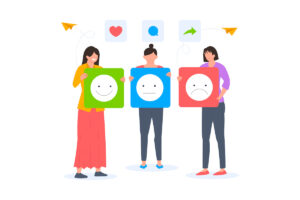As a small or medium-sized business, it’s often difficult to compete with bigger brands’ wallets and available resources. Although your sales and marketing efforts may not carry the same financial clout as your larger counterparts, rest assured that your SMB can have the upper hand in one key area: customer experience (CX).
By building a more human-to-human (H2H) CX, SMBs can develop meaningful connections with customers that will in turn boost loyalty, compel them to return, and create brand advocates. So, how can you do this? Instead of being transaction-focused, your strategy must be customer-focused. You need a humanized business approach to create more emotive, valuable results.
Building Trust with an H2H CX
In an age of personal data sharing, customers expect the companies that acquire their data to benefit or improve the services and products they receive. Personalization, priority access, exclusive benefits, and discounts, are all ways of using data to enhance a customer experience.
A 2017 study found consumers’ emotions play a critical role in determining which brands they are loyal to—and that high emotional engagement with a brand can lead to increased loyalty. Although tangible reward systems make a difference to how loyal customers are, it’s high emotional engagement that can build loyalty in a more meaningful way. Emotionally intelligent approaches are the cornerstone of a humanized marketing approach.
For example, let’s take a look at Tesco, a global brand renowned for its comprehensive loyalty programs. In 2014, the company was involved in an accounting scandal. While it wasn’t enough to significantly damage Tesco in the long term, they lost sales, even though Tesco had some of the best customer loyalty programs around.
Adopting a reliable and transparent approach when it comes to your customers helps to create a relationship based on honest transactions. Being upfront about what you do, how you do it, and respecting customers’ time, data, and purchases is a good start to building trust.
You can do this in lots of ways by putting customers at the center of your CX strategy—share testimonials, use crowdsourced content, and invite them to be a part of your brand. It’s also effective when brands openly share their product development and process. Be transparent about how you source products, who your suppliers are, and the stories behind your services.
3 Ways to Foster Loyalty
Your customers are human (we’re pretty sure), so treat them this way. Build connections, emotionally engage them throughout your business, and work on creating fulfilling relationships with them to foster long-term loyalty. Remember:
- Two-way interaction is important—having healthy, personality-driven discussions with your customers through social media and private messaging creates good impressions. Co-creation is recommended too. Reciprocate the trust customers put in you by inviting feedback, opinions, and even getting them involved in product development. Look at DHL, who boosted customer satisfaction more than 80% and increased revenue through co-creation.
- Using data intelligently helps you anticipate what your customers really want, possibly before they know they want it. If you can personalize their CX in a way that delivers favorable products, services, and messaging, customers will feel more valued. Spotify does this seamlessly with features like Discover Weekly. If you can create personalization across channels, you’re tapping into emotive feelings of familiarity and comfort.
- Make your customers feel special. This doesn’t just have to be through tangible reward schemes—create a combo of benefits, discounts, exclusive offers, invites, and experiences. Subscription-based services work well because they offer exclusive access and monetary incentives, like free shipping.
Originally appeared at Oracle





